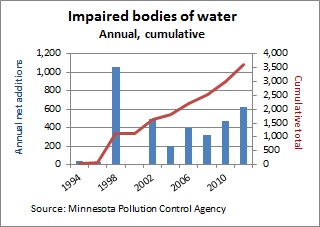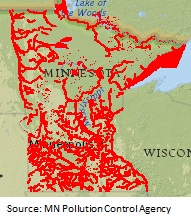In the land of 10,000 lakes, the Minnesota economy has a unique relationship to water that is widely used for fishing, general recreation and even moving goods to market. So it raised some eyebrows when the state announced that more than 600 bodies of water were added this year to its list of impaired lakes and rivers.
But before the “ick” factor makes you put away that canoe, or pull the kids from their favorite swimming hole, it helps to get the background story. Turns out that the measure is more building block than condemnation—a work-in-progress assessment for preserving one of the state’s most valuable natural resources.
Since the mid-1990s, the federal government has required states to assess their water quality. Since then, the number of impaired bodies of water—those that don’t meet various federal water quality standards—has risen steadily and now stands at more than 3,600 (see chart). A map shows that these impaired water bodies are widespread (see map).


While this might not be “good” news for boaters and anglers, neither is it necessarily cause for great concern, according to officials with the Minnesota Pollution Control Agency, which puts the list together. The state has an incredibly large amount of water—92,000 miles of streams alone—and the growing impairment numbers “are indicative of our growing monitoring efforts,” said David Christopherson, who does environmental reporting and special studies for the agency’s water division.
Water bodies make the list if they exceed any number of water quality standards, like turbidity (excessive sediment), eutrophication (too much nutrient, often phosphorous from farm run-off), presence of fecal coliform or a host of other standards. In putting together its biennial impairment report, the agency “uses all available data” from internal and external sources with information about any of the state’s water bodies. As a result, the data are neither comprehensive nor systematic; given that the list comes from a partial assessment, it’s not even a random sample that could be considered scientifically representative.
The list also is highly sensitive to evolving standards for water quality. For example, a huge spike in listings in 1998 was the result of a first-time federal advisory on mercury and fish consumption, and mercury impairment is by far the biggest source of listings. Christopherson added that the state will be applying additional nutrient standards in the near future, “and I would expect to see a big jump (in impairments) then too.”
As a result, he said, “I don’t think (the impairment list) gives us much indication of overall water quality” in the state. Instead, Christopherson said the impairment list is more like a slow-growing benchmark that will give policymakers and others the data necessary to develop a more comprehensive approach to improving and maintaining water quality. “This is a primary driver in terms of what we’re doing” to improve water quality. “Once they get on the list, we have to deal with them.”
He acknowledged that “there are a lot of water quality issues out there. It’s a big issue and will take a long time to address … (but) I don’t think anyone here is particularly surprised” by the growing list of impaired lakes and rivers. The agency generally believes that about 40 percent of water bodies could stand some improvement, and the list “matches what we’ve been finding for years and kind of expected. A lot of other (states) are worse.”
Ron Wirtz is a Minneapolis Fed regional outreach director. Ron tracks current business conditions, with a focus on employment and wages, construction, real estate, consumer spending, and tourism. In this role, he networks with businesses in the Bank’s six-state region and gives frequent speeches on economic conditions. Follow him on Twitter @RonWirtz.





